The pineapple lilies (Eucomis comosa ‘Sparkling Burgundy’, below) are alive and going strong despite a winter that killed too many plants that are considered more cold hardy. There is no explaining this, at least I can’t, and in the face of conflicting results the gardener is overjoyed by the few improbable successes.
Certainly, there are complex circumstances that allow more tender plants to survive while a very cold hardy ‘Bracken’s Brown Beauty’ magnolia (Magnolia grandiflora ‘Bracken’s Brown Beauty’, below) perishes. From the start, I understood that Pineapple lilies were questionable to make it through a typical northwestern Virginia winter, so I would not have been surprised if they had failed. But, ‘Sparkling Burgundy’ appeared this spring as if nothing had happened, and other Pineapple lily cultivars survived, though they came up late and there is no sign that they will flower. 
After an unusually severe winter, there is some justification for the gardener to feel that natural forces are conspiring against him. Throw in damage from summer storms, and it’s been a difficult few years for the garden. Several trees and shrubs in the garden have been severely damaged by snow, ice, or wind, and others suffer from a drainage problem that has turned the lower garden to a swamp for long stretches through winter and spring. But, lessons have been learned, and some mistakes will not be repeated. I’ve been wrong too many times to count, but I think the garden will emerge from this for the better, though it will take a few years.
The Passion flower vine (Passiflora incarnata, above) is quirky regardless of the weather, and particularly so after a cold winter. One year the first growth is seen in May, the next it’s long into June. I didn’t mark the date, but this was a late year for it. But, once it pops out of the ground it takes no time for it to reach the top of its support, and to begin trailing along the wires that have been secured to the aluminum pavilion. The earliest blooms often fall victim to Japanese beetles, and that’s what’s happened again this summer. I thought the beetles were finished since they disappeared from the Ostrich ferns (Matteuccia struthiopteris), but they reappeared and none of the July flowers amount to much. Fortunately, when the vine makes its appearance late, more flowers are delayed into August, so there will be plenty of blooms still to come.
I mistakenly planted the yellow flowered Passion flower (Passiflora lutea, above) on the backside of the large koi pond, where it flourishes. There, it rambles up through Oakleaf and panicled hydrangeas that have grown so wide that it’s difficult to get close enough to enjoy the small yellow flowers. The easiest route to view the vine is to balance along boulders that border the pond. This would be great if I was fourteen and fearless, but with damp rocks and overhanging branches, the footing is just short of treacherous, so I don’t often venture over to see the blooms. Also, this is the favored hangout for the water snake that has taken up residence in the pond, so I must keep a watchful eye for him, and take care of my footing. This is too many things to think about at once, so I’m usually satisfied to visit the purple flowered passion vine instead.